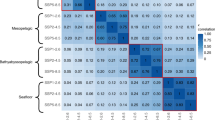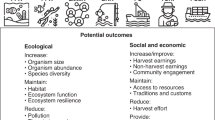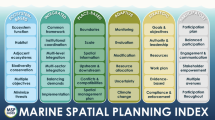Abstract
Establishing representative Marine Protected Area (MPA) networks in Areas Beyond National Jurisdiction (ABNJ) is a priority for the conservation of marine biodiversity and the sustainability of socio-ecological systems under increasing pressure from global environmental change. Here we use a systematic conservation planning framework and four planning scenarios to test the suitability of a bioregional planning approach to deliver a representative network of MPAs for the Southern Ocean. We find that if existing and proposed MPA designs are not adapted, some conservation features will remain underrepresented and very large MPAs in yet to be planned-for domains will be required. Our analysis demonstrates that while existing and proposed Southern Ocean MPAs protect significant conservation features, achieving representative protection under the bioregional approach is contingent on political will to adapt existing protected areas at ongoing stages of the incremental planning process. These findings have implications for conservation planning beyond the Southern Oceans and particular relevance for achieving representative marine protection in ABNJ.
This is a preview of subscription content, access via your institution
Access options
Access Nature and 54 other Nature Portfolio journals
Get Nature+, our best-value online-access subscription
$29.99 / 30 days
cancel any time
Subscribe to this journal
Receive 12 digital issues and online access to articles
$119.00 per year
only $9.92 per issue
Buy this article
- Purchase on Springer Link
- Instant access to full article PDF
Prices may be subject to local taxes which are calculated during checkout



Similar content being viewed by others
Data availability
This study did not generate any new data. All data used to support the findings of this study are referenced and are available from the original sources (Supplementary Table 1).
References
Smith, D. & Jabour, J. MPAs in ABNJ: lessons from two high seas regimes. ICES J. Mar. Sci. 75, 417–425 (2018).
Gardiner, N. B. Marine protected areas in the Southern Ocean: Is the Antarctic Treaty System ready to co-exist with a new United Nations instrument for areas beyond national jurisdiction? Mar. Policy 122, 104212 (2020).
Edgar, G. J. et al. Global conservation outcomes depend on marine protected areas with five key features. Nature 506, 216–220 (2014).
Blicharska, M. et al. Biodiversity’s contributions to sustainable development. Nat. Sustain. 2, 1083–1093 (2019).
Gjerde, K. M. & Rulska-Domino, A. Marine protected areas beyond national jurisdiction: some practical perspectives for moving ahead. Int J. Mar. Coast. Law 27, 351–373 (2012).
Conference of the Parties to the Convention on Biological Diversity. Kunming-Montreal Global Biodiversity Framework Draft decision submitted by the President (UNEP Convention on Biological Diversity, 2022).
Margules, C. R. & Pressey, R. L. Systematic conservation planning. Nature 405, 243–253 (2000).
Conference of the Parties to the Convention on Biological Diversity. Monitoring Framework for the Kunming-Montreal Global Biodiversity Framework Draft decision submitted by the President (UNEP Convention on Biological Diversity, 2022).
Hill, N. et al. Determining marine bioregions: a comparison of quantitative approaches. Methods Ecol. Evol. 11, 1258–1272 (2020).
Ceccarelli, D. M. et al. How to meet new global targets in the offshore realms: biophysical guidelines for offshore networks of no-take marine protected areas. Front. Mar. Sci. 8, 634574 (2021).
Grant, S., Constable, A., Raymond, B. & Doust, S. Bioregionalisation of the Southern Ocean: report of experts workshop, Hobart, September 2006 (WWF Australia & ACE CRC, 2006).
Roberts, C. M. et al. Application of ecological criteria in selecting marine reserves and developing reserve networks. Ecol. Appl. 13, 215–228 (2003).
Wyborn, C. & Bixler, R. P. Collaboration and nested environmental governance: scale dependency, scale framing, and cross-scale interactions in collaborative conservation. J. Environ. Manage. 123, 58–67 (2013).
Ban, N. C. et al. Better integration of sectoral planning and management approaches for the interlinked ecology of the open oceans. Mar. Policy 49, 127–136 (2014).
Fredston‐Hermann, A., Gaines, S. D. & Halpern, B. S. Biogeographic constraints to marine conservation in a changing climate. Ann. N. Y. Acad. Sci. 1429, 5–17 (2018).
Riekkola, L., Andrews-Goff, V., Friedlaender, A., Constantine, R. & Zerbini, A. N. Environmental drivers of humpback whale foraging behavior in the remote Southern Ocean. J. Exp. Mar. Biol. Ecol. 517, 1–12 (2019).
Cashion, T. et al. Shifting seas, shifting boundaries: dynamic marine protected area designs for a changing climate. PLoS ONE 15, e0241771 (2020).
Davies, T. E., Maxwell, S. M., Kaschner, K., Garilao, C. & Ban, N. C. Large marine protected areas represent biodiversity now and under climate change. Sci. Rep. 7, 9569 (2017).
Adams, V. M., Dimitrova, N. & Possingham, H.P. Scheduling incremental actions to build a comprehensive national protected area network for Papua New Guinea. Conserv. Sci. Pract. 3, e354 (2021).
Melbourne-Thomas, J. et al. Poleward bound: adapting to climate-driven species redistribution. Rev. Fish. Biol. Fish. https://doi.org/10.1007/s11160-021-09641-3 (2021).
Sykora-Bodie, S. T. et al. Methods for identifying spatially referenced conservation needs and opportunities. Biol. Conserv. 260, 109138 (2021).
Pressey, R. L., Mills, M., Weeks, R. & Day, J. C. The plan of the day: managing the dynamic transition from regional conservation designs to local conservation actions. Biol. Conserv. 166, 155–169 (2013).
Press, A. J. & Constable, A. J. Conservation Law in Antarctica and the Southern Ocean: the Antarctic Treaty System, conservation, and environmental protection. Aust. J. Int. Aff. 76, 305–323 (2022).
Conservation Measure 91-04 https://www.ccamlr.org/en/measure-91-04-2011 (CCAMLR, 2011).
Brooks, C. M. et al. Progress towards a representative network of Southern Ocean protected areas. PLoS ONE 15, e0231361 (2020).
Reisinger, R. R. et al. Predator-derived bioregions in the Southern Ocean: characteristics, drivers and representation in marine protected areas. Biol. Conserv. 272, 109630 (2022).
Spalding, M. D. et al. Marine ecoregions of the world: a bioregionalization of coastal and shelf areas. BioScience 57, 573–583 (2007).
Meir, E., Andelman, S. & Possingham, H. P. Does conservation planning matter in a dynamic and uncertain world? Ecol. Lett. 7, 615–622 (2004).
CCAMLR MPA Information Repository (CCAMLR, 2021).
Watts, M., Stewart, R. R., Martin, T. G., Klein, C. & Possingham, H. Systematic Conservation Planning with Marxan. In Learning Landscape Ecology (eds Gergel, S. E. & Turner, M. G.) 211–227 (Springer International Publishing, 2017).
Ball, I. R., Possingham, H. P. & Watts, M. E. Marxan and relatives: software for spatial conservation prioritization. In Spatial Conservation Prioritization: Quantitative Methods and Computational Tools 185–195 (Oxford University Press, 2009).
Scientific Committee for the Conservation of Antarctic Marine Living Resources. Report of the 27th Meeting of the Scientific Committee (CCAMLR, 2008).
Sharp, B. R. & Watters, G. M. Marine Protected Area Planning by New Zealand and the United States in the Ross Sea Region (CCAMLR, 2011).
Teschke, K. et al. Planning marine protected areas under the CCAMLR regime – the case of the Weddell Sea (Antarctica). Mar. Policy 124, 104370 (2021).
Carr, M. H., Robinson, S. P. & Wahle, C. The central importance of ecological spatial connectivity to effective coastal marine protected areas and to meeting the challenges of climate change in the marine environment. Aquat. Conserv. 27, 6–29 (2017).
Gell, F. R. & Roberts, C. M. Benefits beyond boundaries: the fishery effects of marine reserves. Trends Ecol. Evol. 18, 448–455 (2003).
Gaines, S. D., White, C., Carr, M. H. & Palumbi, S. R. Designing marine reserve networks for both conservation and fisheries management. Proc. Natl Acad. Sci. USA 107, 18286–18293 (2010).
Goldsworthy, L. Consensus decision-making in CCAMLR: Achilles’ heel or fundamental to its success? Int. Environ. Agreem. https://doi.org/10.1007/s10784-021-09561-4 (2022).
Nilsson, J. A., Fulton, E. A., Haward, M. & Johnson, C. Consensus management in Antarctica’s high seas – past success and current challenges. Mar. Policy 73, 172–180 (2016).
Venegas-Li, R., Levin, N., Possingham, H. & Kark, S. 3D spatial conservation prioritisation: accounting for depth in marine environments. Methods Ecol. Evol. 2018;9:773–784. https://doi.org/10.1111/2041-210X.12896
Game, E. T. et al. Pelagic protected areas: the missing dimension in ocean conservation. Trends Ecol. Evol. 24, 360–369 (2009).
Sykora-Bodie, S. T. et al. Using forecasting methods to incorporate social, economic, and political considerations into marine protected area planning. Front. Mar. Sci. 8, 669135 (2021).
Brooks, C. M., Crowder, L. B., Österblom, H. & Strong, A. L. Reaching consensus for conserving the global commons: the case of the Ross Sea, Antarctica. Conserv. Lett. 13, e12676 (2020).
Hindell, M. A. et al. Tracking of marine predators to protect Southern Ocean ecosystems. Nature 580, 87–92 (2020).
Conservation Measure 91-05 (CCAMLR, 2016).
Brooks, C. M., Epstein, G. & Ban, N. C. Managing marine protected areas in remote areas: the case of the Ssubantarctic Heard and McDonald Islands. Front. Mar. Sci. 6, 631 (2019).
Petit, J. Remote French overseas territory provides huge opportunity for marine conservation. https://www.pewtrusts.org/en/research-and-analysis/articles/2022/02/10/remote-french-overseas-territory-provides-huge-opportunity-for-marine-conservation (PEW, 2022).
Maina, J. M. et al. Aligning marine spatial conservation priorities with functional connectivity across maritime jurisdictions. Conserv. Sci. Pract. 2, e156 (2020).
Goldsworthy, L. Finding the ‘Conservation’ in the Convention on the Conservation of Antarctic Marine Living Resources. Yearb. Polar Law XII, 132–155 (2020).
Haward, M. Biodiversity in Areas Beyond National Jurisdiction (BBNJ): the Commission for the Conservation of Antarctic Marine Living Resources (CCAMLR) and the United Nations BBNJ agreement. Polar J. 11, 303–316 (2021).
Combes, M. et al. Systematic conservation planning at an ocean basin scale: identifying a viable network of deep-sea protected areas in the North Atlantic and the Mediterranean. Front. Mar. Sci. 8, 611358 (2021).
Ban, N. C. et al. Systematic conservation planning: a better recipe for managing the high seas for biodiversity conservation and sustainable use: managing the high seas. Conserv. Lett. 7, 41–54 (2014).
Douglass, L. L. et al. A hierarchical classification of benthic biodiversity and assessment of protected areas in the Southern Ocean. PLoS ONE 9, e100551 (2014).
Raymond, B. 10.2. Pelagic Regionalisation. in The Biogeographic Atlas of the Southern Ocean 418–421 (eds De Broyer, C. & Koubbi, P.) (The Scientific Committee on Antarctic Research, Scott Polar Research Institute, Lensfield Road, Cambridge, CB2 1ER, United Kingdom, 2014).
Bestley, S. et al. Marine ecosystem assessment for the Southern Ocean: birds and marine mammals in a changing climate. Front. Ecol. Evol. 8, 566936 (2020).
Smith, R. The CLUZ plugin for QGIS: designing conservation area systems and other ecological networks. Research Ideas and Outcomes 5, e33510 (2019).
McCook, L. J. et al. Management under uncertainty: guide-lines for incorporating connectivity into the protection of coral reefs. Coral Reefs 28, 353–366 (2009).
Possingham, H. P., Wilson, K. A., Andelman, S. J. & Vynne, C. H. Protected areas: goals, limitations, and design. In Principles of Conservation Biology (eds Groom. M. J, Meffe, G. K., & Carroll, R. C.) 509–533 (Sinauer Associates, Inc., 2006).
Douvere, F. The importance of marine spatial planning in advancing ecosystem-based sea use management. Mar. Policy 32, 762–771 (2008).
Stewart, R. R. & Possingham, H. P. Efficiency, costs and trade-offs in marine reserve system design. Environ. Model. Assess. 10, 203–213 (2005).
Watts, M. E. et al. Marxan with Zones: software for optimal conservation based land- and sea-use zoning. Environ. Model. Softw. 24, 1513–1521 (2009).
MPA Planning Domains (CCAMLR, 2018).
Scientific Committee for the Conservation of Antarctic Marine Living Resources. Report of the 33rd Meeting of the Scientific Committee (CCAMLR, 2014).
Scientific Committee for the Conservation of Antarctic Marine Living Resources. Report of the 31st Meeting of the Scientific Committee (CCAMLR, 2012).
CCAMLR. CCAMLR GIS at https://gis.ccamlr.org/ (2021).
Acknowledgements
We thank B. Raymond, L. Douglass, D. Beaver, J. Freer and E. Woehler for assistance with collating data, J. Turner for GIS support, B. Smith for technical support with CLUZ, and P. Dunstan and M. Haward for advice.
Author information
Authors and Affiliations
Contributions
A.B. was the research leading author. V.A., K.A. and N.H. jointly supervised this work.
Corresponding author
Ethics declarations
Competing interests
The authors declare no competing interests.
Peer review
Peer review information
Nature Sustainability thanks Cassandra Brooks and the other, anonymous, reviewer(s) for their contribution to the peer review of this work.
Additional information
Publisher’s note Springer Nature remains neutral with regard to jurisdictional claims in published maps and institutional affiliations.
Supplementary information
Supplementary Information
Supplementary notes, figures and tables relating to the methods and results presented in the manuscript, data descriptions and access URLs used in the analysis, glossary of terms and references.
Rights and permissions
Springer Nature or its licensor (e.g. a society or other partner) holds exclusive rights to this article under a publishing agreement with the author(s) or other rightsholder(s); author self-archiving of the accepted manuscript version of this article is solely governed by the terms of such publishing agreement and applicable law.
About this article
Cite this article
Boothroyd, A., Adams, V., Alexander, K. et al. Benefits and risks of incremental protected area planning in the Southern Ocean. Nat Sustain 6, 696–705 (2023). https://doi.org/10.1038/s41893-023-01077-w
Received:
Accepted:
Published:
Issue Date:
DOI: https://doi.org/10.1038/s41893-023-01077-w



